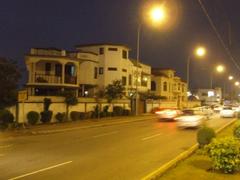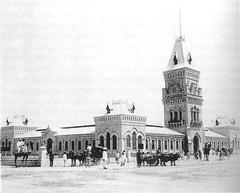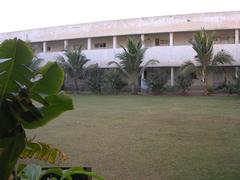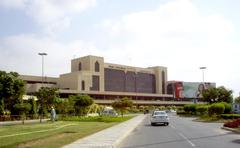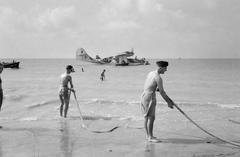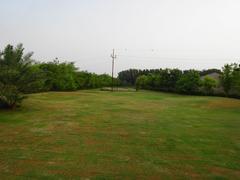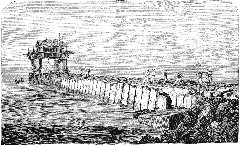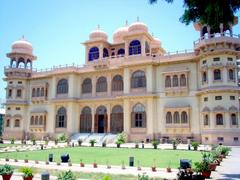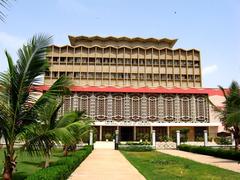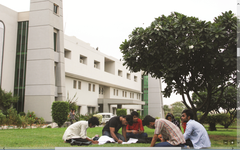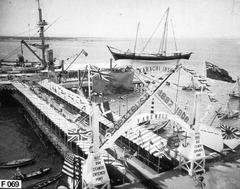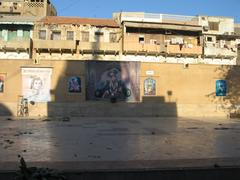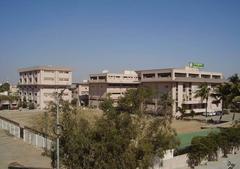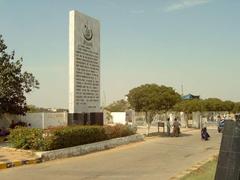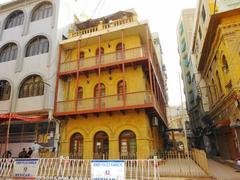
Aga Khan University Hospital Karachi: Visiting Hours, Tickets, and Guide to Historical Sites
Date: 04/07/2025
Introduction
Karachi, the bustling heart of Pakistan, is renowned for its diverse cultural, historical, and architectural landmarks. Among these, the Aga Khan University Hospital (AKUH) stands out as a beacon of medical excellence, architectural innovation, and community service. Founded in 1985 by His Highness the Aga Khan IV, AKUH is more than a hospital—it’s an institution that integrates world-class healthcare, research, and education while reflecting the region’s rich heritage (Payette; Wikipedia).
Karachi is also home to significant heritage sites, such as the Aga Khan Mausoleum—the resting place of Sir Sultan Muhammad Shah Aga Khan III—and the Quaid-e-Azam Mausoleum, honoring Pakistan’s founder, Muhammad Ali Jinnah. Together, these sites offer visitors a unique lens into Karachi’s layered history and vibrant cultural identity (AKDN; Karachi Tourism Guide).
This guide provides a comprehensive overview for visitors and researchers interested in AKUH and Karachi’s historical sites. It includes detailed information on the hospital’s origins, architectural philosophy, visitor logistics (visiting hours, tickets, accessibility), and insights into nearby attractions—ensuring an enriching and seamless experience for healthcare professionals, history enthusiasts, and cultural explorers alike.
Table of Contents
- Introduction
- Historical Genesis and Visionary Foundations
- Architectural Philosophy and Design Principles
- Growth, Expansion, and Modernization
- International Recognition and Influence
- Cultural and Social Significance
- Practical Visitor Information: Visiting Hours, Tickets, and Accessibility
- FAQ: Your Questions About Visiting Aga Khan University Hospital
- Visuals and Media
- Conclusion: A Living Legacy of Healing and Culture
- Guide to the Aga Khan Mausoleum
- Guide to the Quaid-e-Azam Mausoleum
- Summary of Key Points and Final Tips
- References
Historical Genesis and Visionary Foundations
The inception of AKUH began in 1971 when His Highness the Aga Khan IV envisioned a leading academic medical center for Pakistan. This vision materialized in 1985 with the opening of AKUH, realized through a significant investment from Prince Karim Aga Khan and land provided by the Pakistani government (Payette; Wikipedia). The hospital was established to serve as the primary teaching site for the Aga Khan University’s Faculty of Health Sciences, integrating patient care, education, and research (Ismailimail).
Architectural Philosophy and Design Principles
AKUH’s design harmonizes modern healthcare infrastructure with the cultural and environmental context of Karachi.
Integration with Environment and Climate
To address Karachi’s hot and humid climate, the architects designed a series of interconnected buildings, verandas, and courtyards. These shaded, landscaped spaces, often featuring water elements, create tranquil environments for patients and visitors while moderating the microclimate (Payette). This approach was ahead of its time, anticipating the global trend of healing gardens in healthcare settings.
Materiality and Symbolism
The hospital’s signature red-brick and stone facades draw from local architectural traditions, ensuring durability and low maintenance. The interplay of light, shadow, and color—especially the distinctive pink and red hues—has become an iconic element of the campus, symbolizing warmth and rootedness (AKUH Official; Aurora Magazine).
Spatial Organization and User Experience
AKUH’s campus is organized around multiple courtyards, each serving distinct functions such as family waiting, private reflection, or social gathering. The integration of hospital buildings, the medical college, nursing school, housing, and a mosque fosters community and collaboration, all within a navigable and welcoming environment (Wikipedia; Payette).
Growth, Expansion, and Modernization
AKUH has continually expanded to meet growing healthcare needs and technological advancements. The hospital today accommodates 721 beds, 17 operating theatres, advanced diagnostic centers, and specialty care units. The addition of a private wing in 2020 further enhanced its capacity for premium care, while maintaining accessibility for the broader community (BlogPakistan; AKUH Official).
International Recognition and Influence
AKUH has earned international accreditation and recognition for its quality and safety standards. It was the first teaching hospital in Pakistan to achieve ISO 9002 and ISO 9001 certifications, and remains the country’s only Joint Commission International (JCI)-accredited academic medical center (Ismailimail; AKUH Health Solutions). Its patient-centered design and operational model have influenced healthcare facilities across the region (Aurora Magazine).
Cultural and Social Significance
AKUH is a symbol of the Aga Khan Development Network’s commitment to holistic well-being—combining medical care, education, and cultural preservation. The campus’s mosque, gardens, and gathering spaces reflect values of compassion, dignity, and community central to South Asian and Islamic traditions (Aurora Magazine; Payette).
Practical Visitor Information: Visiting Hours, Tickets, and Accessibility
Visiting Hours
- General visiting hours: 9:00 AM to 9:00 PM daily
- Emergency and ICU: Restricted hours—confirm with the hospital before visiting
Entry and Tickets
- Admission: Free for all visitors, patients, and families
- Special events or educational programs: May require registration (check official channels)
Accessibility and Parking
- Wheelchair accessible: Ramps, elevators, and wheelchairs available
- Parking: Multiple on-campus lots, free and paid valet options, clear directional signage
Transportation and Getting There
- Location: Stadium Road, Karachi
- Access: Taxi, ride-sharing apps, and public transport routes available
Guided Tours and Visitor Services
- Tours: Architectural or educational tours may be arranged by request through the university’s outreach or visitor services
- Contact: Reach out to AKUH for research, collaboration, or tour inquiries
Nearby Attractions and Photographic Spots
- On-campus: Landscaped courtyards, water features, and red-brick facades
- Nearby: Quaid-e-Azam Mausoleum, Frere Hall, Pakistan Maritime Museum
FAQ: Visiting Aga Khan University Hospital
Q: What are the visiting hours?
A: 9:00 AM to 9:00 PM daily; some departments have restricted access.
Q: Is there an entry fee?
A: No, entry is free.
Q: Is parking available?
A: Yes, both free and paid options.
Q: Is the hospital accessible for wheelchairs?
A: Yes, with ramps and elevators throughout.
Q: Can I arrange a guided tour?
A: Yes, by prior request via the university’s visitor office.
Q: How do I get there by public transport?
A: Stadium Road is served by taxis, ride-sharing, and city buses.
Visuals and Media
For official images and virtual tours, visit the AKUH website. Photographers will find excellent daylight opportunities across the campus’s courtyards, gardens, and distinctive facades.
Conclusion: A Living Legacy of Healing and Culture
The Aga Khan University Hospital is a model of visionary healthcare, thoughtful architecture, and cultural sensitivity. Its foundation and continued growth symbolize the integration of innovation, compassion, and community service in Pakistan’s urban landscape.
Visitors to AKUH, as well as the city’s other major historical sites, can expect an experience that is as educational as it is inspiring. For more information, download the Audiala app, consult our related articles, and follow us on social media.
Guide to the Aga Khan Mausoleum
Overview
The Aga Khan Mausoleum in Karachi is a significant cultural and historical landmark, serving as the final resting place of Sir Sultan Muhammad Shah Aga Khan III. It is recognized for its unique architectural style and tranquil ambiance, making it a destination for history enthusiasts and cultural explorers (AKDN).
History and Cultural Significance
Constructed in the early 20th century, the mausoleum commemorates Aga Khan III’s contributions to education, social reform, and community development, serving as a testament to Karachi’s heritage and the Ismaili community’s enduring legacy.
Visiting Hours and Tickets
- Hours: 9:00 AM to 5:00 PM daily; longer hours during public holidays
- Entry: Free of charge
- Guidelines: Modest dress and respectful behavior are required
Guided Tours and Visitor Information
- Guided tours: Available on request via local agencies or Ismaili community centers
- Photography: Permitted (no flash inside)
- Facilities: Restrooms, seating, multilingual signage, and brochures available
Accessibility and Amenities
- Wheelchair accessible: Ramps and paved pathways
- Parking: Available nearby
Special Events and Cultural Programs
Occasional cultural and commemorative events are held, especially on significant anniversaries related to Aga Khan III. These are open to the public and provide opportunities for community engagement.
Nearby Attractions
- Frere Hall
- Mohatta Palace
- Quaid-e-Azam’s Mausoleum
Guide to the Quaid-e-Azam Mausoleum
Overview
The Quaid-e-Azam Mausoleum (Mazar-e-Quaid) is Karachi’s most prominent landmark and the final resting place of Muhammad Ali Jinnah, the founder of Pakistan. The striking white marble structure is a symbol of the nation’s independence and pride (visitpakistan.com/mazar-e-quaid).
History and Cultural Significance
Built between 1960 and 1970, the monument blends modern and Islamic architectural elements, reflecting unity and progress. It is a focal point for national celebrations and remembrance.
Visiting Hours and Tickets
- Hours: 9:00 AM to 5:00 PM daily
- Entry Fee: None
- Guided Tours: Available on request
Location and Accessibility
- Central Karachi: Easily reached by public transport, taxi, or ride-sharing
- Wheelchair accessible: Ramps and smooth pathways
- Parking: Nearby facilities
Architectural Highlights
- Cube-shaped structure with a large dome
- White marble exterior from Makrana quarries
- Four minarets at the corners
- Intricate geometric and calligraphic interior designs
Visitor Facilities
- Restrooms and prayer areas
- Adjacent museum with artifacts and exhibits
- Souvenir shops
Nearby Attractions
- Frere Hall
- Mohatta Palace
- Clifton Beach
Visitor Tips
- Visit early to avoid crowds and midday heat
- Dress modestly out of respect
- Photography allowed (no flash inside)
Summary of Key Points and Final Tips
The Aga Khan University Hospital is not only a premier healthcare institution but also an architectural and educational landmark that reflects the visionary aspirations of the Aga Khan Development Network (AKUH Official). Its blend of modern medical technology, culturally resonant design, and community focus sets a benchmark for healthcare in the region.
Complement your visit to AKUH with trips to the Aga Khan Mausoleum and Quaid-e-Azam Mausoleum for a deeper understanding of Karachi’s heritage. All sites are accessible, admission is free, and guided tours are available for those seeking an enriched experience (AKDN; Quaid-e-Azam Mausoleum Guide).
For the latest updates and comprehensive travel resources, use the Audiala app and consult official tourism websites. Embrace this unique journey into Karachi’s history, architecture, and humanitarian legacy.
References
- Payette Associates: Aga Khan University Hospital Legacy
- Aga Khan University Hospital, Karachi - Wikipedia
- The History of the Aga Khan Health Services – Ismailimail Blog
- Private Hospitals in Karachi – BlogPakistan
- Aga Khan University Hospital Official Website
- Aga Khan Mausoleum Karachi – AKDN
- Visiting the Historic Aga Khan Mausoleum – Official Ismaili Community
- Visiting the Quaid-e-Azam Mausoleum – Karachi Tourism
- Karachi Tourism Guide – Pakistan Tourism Development Corporation
- Aurora Magazine Article on Aga Khan University Hospital – Dawn


